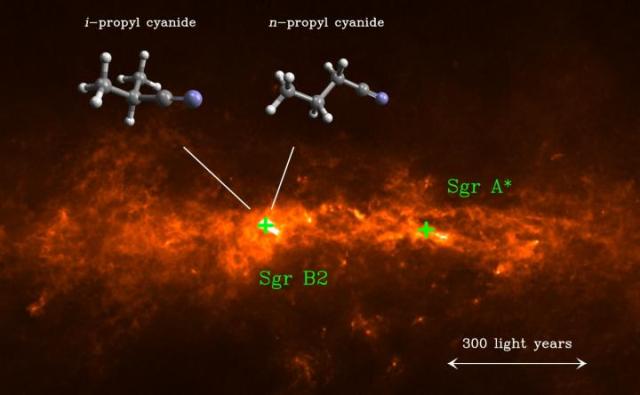 "This image shows dust and molecules in the central region of our galaxy. The background image shows the dust emission in a combination of data obtained with the APEX telescope and the Planck space observatory at a wavelength around 860 micrometers. The organic molecule iso-propyl cyanide with a branched carbon backbone (i-C3H7CN, left) as well as its straight-chain isomer normal-propyl cyanide (n-C3H7CN, right) were both detected with the Atacama large millimeter/submillimeter array in the star-forming region Sgr B2, about 300 light years away from the Galactic center Sgr A*. Credit: MPIfR/A. Weiss (background image), University of Cologne/M. Koerber (molecular models), MPIfR/A. Belloche (montage)"
"This image shows dust and molecules in the central region of our galaxy. The background image shows the dust emission in a combination of data obtained with the APEX telescope and the Planck space observatory at a wavelength around 860 micrometers. The organic molecule iso-propyl cyanide with a branched carbon backbone (i-C3H7CN, left) as well as its straight-chain isomer normal-propyl cyanide (n-C3H7CN, right) were both detected with the Atacama large millimeter/submillimeter array in the star-forming region Sgr B2, about 300 light years away from the Galactic center Sgr A*. Credit: MPIfR/A. Weiss (background image), University of Cologne/M. Koerber (molecular models), MPIfR/A. Belloche (montage)"
Researchers belonging to Max Planck Institute for Radio Astronomy (Bonn, Germany), University of Cologne (Germany), and the Cornell University (USA) have discovered a “branched” carbon-bearing molecule in interstellar space for the very first time.
The detection and analysis of interstellar space molecules has been in progress since the 1960s. So far 180 molecular entities have been detected. The ones discovered by the researchers are not only organic carbon-bearing but also rich in hydrogen, making these molecules nearly resemble those found on earth.
The new molecule is called iso-propyl cyanide (i-C3H7CN) and was found in Sagittarius B2 (Sgr B2), an enormous gas cloud. Iso-propyl cyanide is completely unique from all other previously discovered molecules, which have a straight-chain carbon backbone.
The branched carbon backbone formation of the new molecule is a clear indicator of existence of amino acids, and would be very useful on earth.
The team lead, Arnaud Belloche stated that it is critical to learn about the development of the molecules right at the beginning when a star is forming as it would aid in the study of life-essential chemicals in the molecules.
To study the newly discovered molecules in Sgr B2, the researchers chose the Atacama Large Millimeter/submillimeter Array (ALMA), in Chile. The distance of the Sgr B2 from the sun is around 27,000 light years . The ALMA however enabled them to clearly study wavelengths between 2.7 and 3.6mm with a spatial resolution and sensitivity ten times more than previous studies and also in much lesser time.
The researchers have built computational models capable of replicating the chemical structure of the iso-propyl cyanide. The highlight of discovering these new molecules with their side-chain structure is the fact that amino acids are most likely to be present in interstellar space. The team hopes to discover them in the coming days.
References